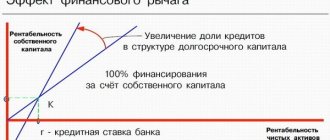Free cash flow is the funds remaining at a company's disposal after investments have been made and all liabilities have been paid off. Free and net cash flow should not be confused - these are two completely different concepts. Net cash flow (described in the article of the same name) is simply the difference between income and expenses, and free cash flow is what remains after expenses for the acquisition and modernization of assets. Such expenses, as we remember, are called CAPEX, and there is also a separate article about them.
And today we’ll talk about why free cash flow is needed, how this indicator is used in practice, and we’ll look at a practical example.
What is free cash flow
So, free cash flow (or free cash flow) is the funds remaining after payments:
- on current operations;
- taxes;
- percent;
- CAPEX.
Let's start with the fact that there are accounting statements that indicate net profit. And there are management reports where profit means money. The fact that taxable or retained earnings in reporting and money are not the same thing is known to every financier. Nevertheless, I remind you of this in order to understand how, without having access to the company’s management (internal) reporting, one can calculate such an important indicator for an investor as free cash flow, which for convenience we will abbreviate as FCF. This can be done if there is a cash flow statement, which is included in the set of mandatory accounting reports for large companies.
Why is this indicator needed?
There is one important point: free cash flow is partially spent on paying off obligations on loans and borrowings. That is, one of the persons interested in its calculation are banks that provide loans to companies.
Such loans are most often issued to replenish working capital. Having calculated the FCF value, which, by the way, can be negative, the bank specialist makes a decision on the limit of the loan issued.
Further, income is paid to shareholders from free money. So investors are the second category of people interested in analyzing free cash flow.
And finally, business owners also want to know how much money will be left after all the above payments and how these funds can be used to generate income.
There are two formulas for calculating free cash flow, which are used depending on the category of interested parties. Let's consider each type of FCF separately.
Net Cash Flow - what is it?
Net cash flow (in English “Net Cash Flow”, NCF) is defined as the sum of positive and negative transactions.
The net cash flow formula is formed from three components:
NCF = CFO + CFF + CFI
Where:
- CFO - operating activities (Cash Flow from operating activities, CFO or Operating Cash Flow, OCF). Profit from the main activities of the company. This already includes depreciation, accounts receivable and credit, and other liabilities and assets.
- CFI - investment activities (Cash Flows from investing activities, CFI). Investments in modernization and business expansion.
- CFF - financial activities (Cash Flows from financing activities, CFF). Payments of dividends, loan payments, share repurchases, and other financial transactions.
Free Cash Flow calculation methods
FCF can be calculated for both current performance analysis and forecasting purposes. Of course, current activity implies what is happening in this reporting period, and all indicators are calculated based on the results of previous years, since the report on the movement of capital assets and the calculation of CAPEX are compiled based on the results of the year.
For different purposes, different methods of calculating free cash flow are used.
- The simplest method is to calculate free cash flow (FCF) using the first formula:
\[ FCF =CFO – CAPEX \]
This method is used in express analysis of a company's solvency and is the most common and convenient.
To obtain a more accurate result, there are two more methods.
- Adjusted free cash flow. The formula given above is adjusted by the amount of change in current assets, income tax and interest:
\[ FCF = [EBITDA] – [NPR] – [CAPEX] +/– [NWCC], where: \]
\( EBITDA \) – profit excluding tax, interest and depreciation;
\( NPR \) – income tax;
\( NWCC \) – change in working capital.
Here are a few more formulas to reveal the components of this calculation:
\[ EBITDA = PE + R&D + Pr + A, where: \]
\( PE \) – net profit;
\( A \) – depreciation of non-current assets.
Cash flow statement ratios.
The cash flow statement contains information that can be analyzed over time (that is, changes over time) to gain a better understanding of a company's past performance and its future prospects.
This information can also be used effectively to compare the performance and prospects of different companies within the same industry, as well as across different industries.
There are several generally accepted ratios based on cash flow from operating activities that can be useful in this analysis. These ratios are usually categorized as 'performance / profitability ratios' and 'coverage / solvency ratios' for cash flow .
See also:
CFA - Financial Ratio Analysis.
Figure 16 summarizes the calculation and interpretation of some of these coefficients.
Illustration 16. Cash flow statement ratios.
Profitability ratios
| Index | Formula | Economic meaning of the indicator |
| Cash flow to revenue | CFO/Net Revenue | Operating cash flow received for each unit. revenue |
| Cash return on assets | CFO/Average Total Assets | Operating cash flow received for each unit. investment in assets |
| Cash flow to equity | CFO / Average equity (shareholder) capital | Operating cash flow received for each unit. investments of company owners |
| Cash flow to operating profit (Cash to income) | CFO / Operating profit | A company's ability to generate cash flows from profits generated from operating activities |
| Cash flow per share a | (CFO - Dividends on preferred shares) / Number of common shares outstanding | Operating cash flow per 1 ordinary share |
Coverage or Solvency Ratios
| Index | Formula | Economic meaning of the indicator |
| Debt coverage ratio | CFO/Total Debt Obligations | Level of financial risk and financial leverage |
| Interest coverage coefficient b (Interest coverage) | (CFO + Interest paid + Taxes paid) / Interest paid | Ability to meet interest repayment obligations |
| Reinvestment ratio | CFO / Payments for (investments in) non-current assets | Ability to acquire fixed assets and other non-current assets using operating cash flow |
| Debt payment ratio | CFO / Payments to repay long-term debt obligations | Ability to repay long-term debt obligations through operating cash flow |
| Dividend payment ratio | CFO / Dividend payments | Ability to pay dividends from operating cash flow |
| Investing and financing ratio | CFO / Cash outflows from investing and financing activities | The ability to acquire non-current assets, pay off debts and pay dividends. |
Notes:
a If a company reports under IFRS and includes dividends paid in the operating activities section of the statement of cash flows, then the total dividends reported must be added to CFO and then subtracted dividends on preference shares.
Let us remind you that CFO in cash flow statements prepared in accordance with US GAAP and IFRS may differ due to the reflection of interest and dividends received and paid in different sections.
See also more details from this:
CFA - Preparation of the Cash Flow Statement (Part 1): Relationship to the Balance Sheet and Operating Activities.
b If a company reports in accordance with IFRS and includes interest payments in the financing activities section, then interest payments must be excluded from the numerator.
Application
So, free cash flow is calculated in order to:
- analysis of the company's solvency, necessary for creditors and investors;
- forecasting the magnitude of cash flows and their discounting. When making forecasts, inflation must be taken into account. For this purpose, cash flow discounting is used, which is described in the article of the same name.
- determining the value of the company and its development prospects.
The main objective of FCF is to assess the ability of an enterprise to effectively use borrowed funds and attracted investments, while fulfilling all obligations in a timely manner. In simple words, calculating free cash flow is needed to answer a simple question: is a company, having received a loan, able to make a profit from it, or will the debt burden pull it towards bankruptcy.
FCF calculation examples
Let's calculate free cash flow using two methods: simple and more complex, using formulas and data from the balance sheet and cash flow statement.
Example 1. I will give several screenshots of the financial statements of PJSC GAZPROM so that you can clearly see where the necessary data came from:
CFO = 618632855 thousand rubles.
CAPEX = 216191 + (25838393 –25739724) + 3414766 + 3247836 + 929765550 + 6882732 = 943625744 thousand rubles.
FCF = 618632855 – 943625744 = –324992889 thousand rubles.
The negative value was due to the high costs of unfinished construction. Perhaps this situation is temporary. Let's calculate the adjusted FCF in example 2.
Example 2. We will take the same enterprise, but we will present the initial data in the table.
| Indicator name | 2019 | 2018 |
| CFO | 618632855 | X |
| CAPEX | 943625744 | X |
| Net profit | 651124114 | X |
| Income tax | 187389340 | X |
| Percentage to be paid | 107234097 | X |
| Depreciation | 669737902 | X |
| EBITDA | 1615485453 | X |
| Current assets | 3424088958 | 3830923087 |
| Short-term liabilities | 2078766034 | 1955540509 |
| N.W.C. | 1345322924 | 1875382578 |
| N.W.C.C. | -530059654 | X |
FCF = 1615485453 – 187389340 – 943625744 – 530059654 = –45589285 thousand rubles.
As you can see, the calculation based on profit gave us a completely different value, but also negative. What can be concluded?
Everything is very simple. Firstly, income from investment activities is included in the calculation of profit. Secondly, profit is calculated based on shipment. And thirdly, despite the deterioration of all indicators in 2019 compared to 2022, net profit still covers all current liabilities. It is important to consider that we are analyzing a company that is one of the most quoted on the stock market. This means that it is also necessary to take into account the increase in equity capital and the current value of shares.
Setting up FCF formulas in 1C programs
Settings in 1C:ERP 2 are set in the “Budgeting and Planning” section. By setting up “Budget reports” we arrive at specific, single instances of budgets.
Fig.1 Settings for budgeting and planning
Fig.2 Form for entering the discount rate used in NPV calculations
Fig. 3 Example of setting up a budget type and NPV indicator indicating the formula
In “1C: Holding Management”, settings for calculation formulas are possible in reports, namely in report forms available on the “Budgeting, reporting and analysis” tab, in the “Types and forms of reports” item.
Fig.4 Report forms
Formulas are directly entered in the “Report Designer”; links to indicators of other calculated reports are possible.
Fig. 5 Example of entering the FCF formula into the financial reporting form
CPM 1C class solution: Holding Management 8 for cash flow management
The main tool in the specialized financial solution WA: Financier will be “Custom Reports”. In them, formulas are entered on the layout in an Excel-like form.
Fig.6 Setting up formulas in the table
Formulas can be entered through Cell Setup or through Options.
Fig. 7 Example of setting up FCFF calculation using “Cell Settings”
Unique solution WA: Financier for cash flow analysis
Setting up NPV in 1C
After multi-stage setup in 1C:ERP 2 , first of all, graphical reports are available.
Fig.8 Graphic report on NPV
NPV calculations involve a separate type of budget.
Fig. 9 Types of budgets
Setting up the budget type allows you to use many indicators.
Fig. 10 Setting up the budget type
The rules for obtaining data are configured separately.
Fig. 11 Setting up a data acquisition rule
The report itself can be made in tabular form.
Fig. 12 NPV report
To work with investment projects in 1C:UH there is a section of the same name on the “Agreements and Projects” tab. It specifies the main elements: project stages, investment programs and their blocks, as well as the projects themselves. Below is a possible layout for one of the projects with the calculation of the main indicators for it, including NPV.
Fig. 13 Report on key indicators of the investment project
From the “Operational planning documents” you can go to the planning documents for the project.
Fig. 14 Operational planning documents
Calculation in Excel
Let's calculate free cash flow using a simplified formula and adjusted FCF for X5 Retail Group for 2022 using the Excel editor.
It may seem strange that when working capital falls, free cash flow is positive. In fact, it is enough to analyze the structure of short-term liabilities:
As you can see, the capitalized lease indicator has increased, due to which there has been a downward change in working capital. This indicator is more correctly classified as long-term liabilities. If we exclude it from the calculations, we get the following picture:
So, the NWCC indicator (change in working capital) takes a positive value, and FCF has increased by more than 2.5 times. Thus, it is always necessary to analyze items of working capital and short-term liabilities and make calculations, taking into account the characteristics of the company: organizational and legal form, availability of own shares, industry, etc. It is for such purposes that the information in the reporting is presented in the most detailed form - this is within the competence of auditors.
What is the difference between free cash flow and net income
The examples above clearly explain the difference between free cash flow and net profit: FCF consists only of cash expenses, profit also takes into account non-cash costs (for example, depreciation). Also, when calculating free cash flow, the change in working capital (NCW) is taken into account.
Please note that changes in the NER should be taken into account as follows:
- if working capital has decreased, it is deducted when calculating FCF;
- if it has increased, they add it.
In some examples on the Internet, only the minus sign is given in the formula. Thus, if working capital has decreased, and when calculated according to the rules of mathematics, minus by minus gives a plus, the wrong result is obtained.
Why is this delta taken into account when calculating free cash flow? Of course, this is an indirect indicator. Nevertheless, a significant change in working capital indicates a change in the composition of receivables and payables, the balance of inventory in the warehouse, and financial investments. In other words, a change in the NSC shows that the company is developing, or problems are arising with the fulfillment of obligations. All these factors directly affect the amount of free cash flow.
What influences Cash flow
There are external and internal factors that ultimately influence the results of cash flow calculations.
External factors:
- Conditions of the commodity and stock markets;
- Taxation;
- Practice of lending to suppliers and buyers of products;
- Carrying out settlement transactions of business entities;
- Availability of financial credit;
- Possibility of attracting gratuitous targeted financing;
Internal factors:
- Life cycle;
- Duration of the operating cycle;
- Seasonality;
- Investment programs;
- Depreciation;
- Operating leverage ratio;
- Corporate governance;










